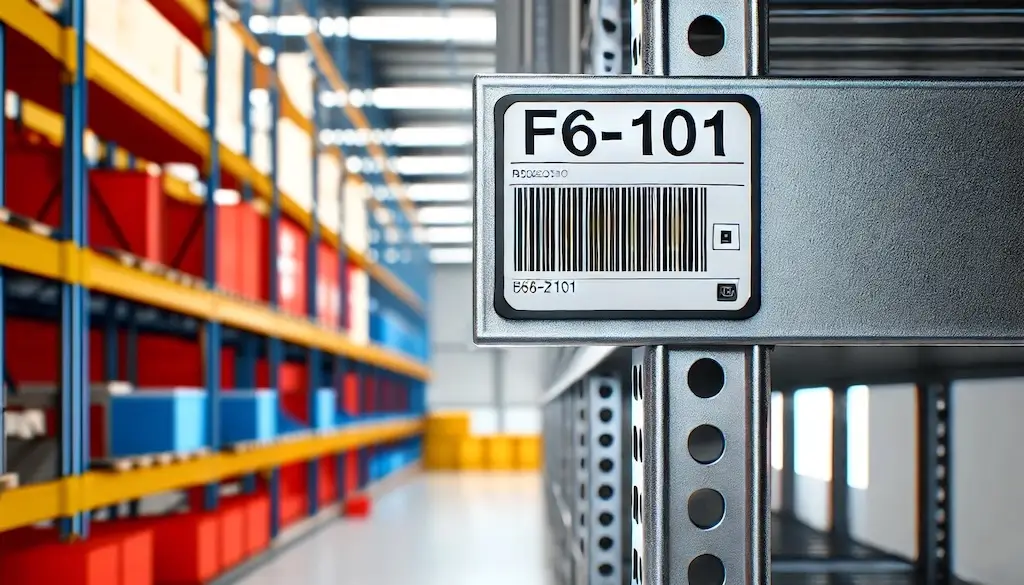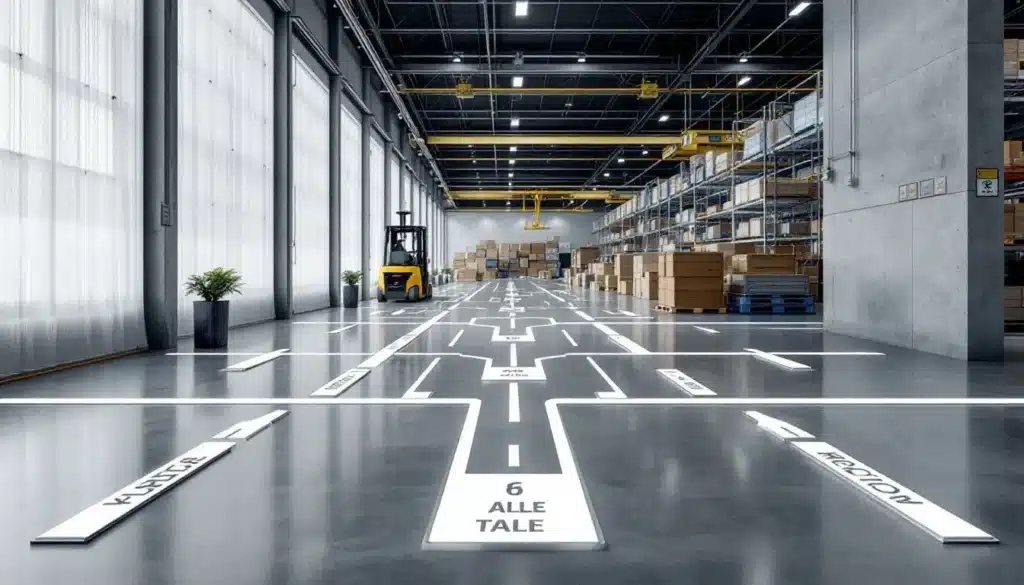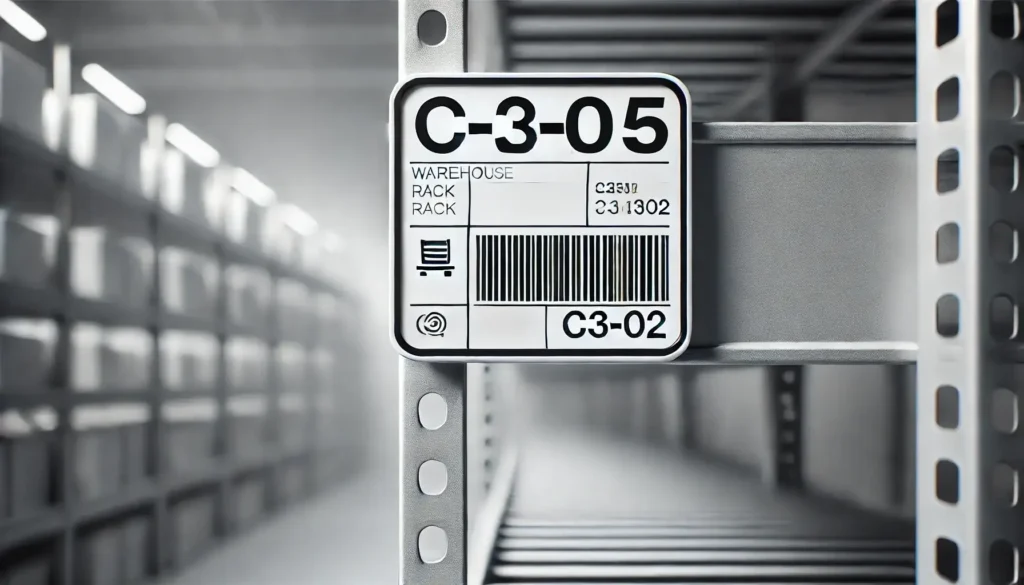Warehouse labels are key to efficient inventory management. They help in organizing stock, reducing mistakes, and boosting productivity. This guide will explore different types of warehouse labels and their uses, offering tips on selecting the right labels for your warehouse needs.
Key Takeaways
- Various types of warehouse labels, including self-adhesive, magnetic, and blank labels, are essential for efficient inventory management and adaptability in dynamic environments.
- Implementing a systematic labeling strategy, such as using rack labels and barcodes, significantly enhances navigation, reduces errors, and improves overall operational efficiency within warehouses.
- Choosing high-quality materials and proper label placement, along with engaging specialized label providers, is crucial for ensuring the durability and effectiveness of labeling systems in a warehouse setting.
Types of Warehouse Labels

Warehouse labels come in various types, each serving different purposes within a warehouse management system. From self-adhesive labels that resist environmental factors to magnetic labels that offer flexibility in dynamic environments, understanding these options is crucial for effective warehouse labeling.
Blank labels also provide versatility, allowing customization specifically designed to meet specific needs.
Self-Adhesive Labels
Self-adhesive labels are a staple in warehouse labeling due to their durability and long-lasting adhesion. These labels maintain their stickiness even in challenging conditions, making them ideal for long-term applications. They are particularly effective on metal surfaces, such as steel shelving and racking, ensuring that inventory can be easily tracked and managed.
The effectiveness of self-adhesive labels largely depends on the quality of the materials used and the initial tack of the adhesive. High-quality adhesives ensure that the labels remain intact over time, despite exposure to moisture, UV light, and other environmental factors. This makes them a reliable choice for various warehouse applications, from rack labels to barcode labels.
Magnetic Labels
Magnetic labels offer a unique advantage in warehouses with frequently changing layouts. Their ability to be repositioned easily makes them highly adaptable to dynamic environments. Whether it’s for temporary labeling needs or frequently changing inventory setups, magnetic labels provide the flexibility required to keep up with operational changes.
These labels are designed for easy attachment and detachment, allowing workers to swiftly update labeling as needed. The reusability of magnetic labels also means there is no need to constantly produce new labels, making them a cost-effective solution for warehouses that require frequent updates to their labeling system.
Blank Labels
Blank labels are the epitome of versatility in warehouse labeling. They can be easily customized on-site, allowing warehouses to adapt quickly to changing inventory and operational needs. Whether it’s marking containers, shelves, or specific ground locations, blank labels provide the flexibility to meet various labeling requirements, including the use of a warehouse label.
The ability to personalize blank labels ensures that warehouses can respond promptly to new demands and reorganize as necessary. This adaptability is essential for maintaining efficient warehouse operations and ensuring that all areas are appropriately labeled to match the current inventory setup.
Importance of Rack Labels
Rack labels are indispensable for enhancing warehouse efficiency. They provide clear and accessible identification of storage areas, facilitating quick navigation through the warehouse. Implementing a systematic labeling strategy, including color coding and directional arrows, improves visibility and reduces errors, making inventory management more effective.
Barcode Labels for Racks
Barcode labels are a cornerstone of modern warehouse management systems. Featuring both a barcode image and human-readable letters and numbers, these labels allow for swift and precise item identification on racks. Scanning an LPN label provides vital information such as quantity, pertinent dates, and lot numbers, streamlining the processes of shipping and receiving. Barcodes play a crucial role in this efficient system.
Effective placement of barcode labels is crucial. They should be placed in clear and accessible locations on racks to minimize obstructions and maximize clarity. Color-coded labels and arrows can further enhance the speed and efficiency of inventory retrieval processes, ensuring that workers can easily find what they need without wasting time.
Customizable Rack Labels
Customizable rack labels offer tailored solutions to meet specific warehouse conditions and user requirements. Customizing these labels for specific storage needs allows warehouses to optimize space usage and boost overall efficiency.
This flexibility ensures that the labeling system can adapt to unique operational demands, providing a more organized and effective storage environment.
Floor Labels for Navigation and Safety

Floor labels play a critical role in warehouse navigation and safety. These labels reduce accidents and boost operational efficiency by marking specific pallet locations and defining pedestrian and vehicle pathways.
The use of vibrant colors and clear markings ensures that floor labels are easily noticeable, guiding workers and machinery safely through the warehouse.
Printed Floor Markings
Printed floor markings are designed to withstand high traffic and ensure longevity. Using high-wear epoxy for these markings guarantees durability, even in the busiest areas of the warehouse.
Color coding on these labels helps workers quickly identify the correct storage locations, enhancing the overall efficiency of the warehouse.
Safety Floor Labels
Safety floor labels are essential for marking hazardous areas within the warehouse. Properly marked hazardous zones reduce the risk of injury by alerting workers to potential dangers. Color-coded safety labels effectively communicate different levels of hazard, ensuring that workers are aware of restricted access areas and can navigate the warehouse safely.
Letters & Numbers for Versatile Labeling
Letters and numbers are versatile tools for warehouse labeling. They can be used to label large metal surfaces, equipment, and steel cabinets, providing clear identification across various applications.
These labels enhance the organization and efficiency of warehouse operations by clearly defining storage areas and inventory.
Magnetic Letters & Numbers
Magnetic letters and numbers are an effective solution for labeling large metal surfaces. Their removability and ease of repositioning provide flexibility for warehouses with frequently changing stock placements. These labels can be effortlessly installed on metallic surfaces, reducing installation time and allowing for quick updates as inventory changes.
The versatility of magnetic letters and numbers makes them suitable for various warehouse environments. Whether it’s temporary labeling needs or permanent markers, their adaptability ensures that the warehouse remains organized and efficient.
Self-Adhesive Letters & Numbers
Self-adhesive letters and numbers are designed for long-lasting use, making them suitable for both indoor and outdoor labeling. Their robust construction ensures they maintain integrity and visibility in diverse environments, adhering to various surfaces with ease.
This durability makes them a reliable choice for permanent labeling needs within the warehouse.
Enhancing Warehouse Operations with Location Labels
Location labels are pivotal in enhancing warehouse operations by improving visibility and organization. They allow workers to quickly locate products in a vast space, significantly boosting efficiency. Barcode labels can be scanned to instantly retrieve product information, reducing inventory errors and improving management processes.
License Plate Numbers
License Plate Numbers (LPNs) are unique identifiers for each pallet, enhancing tracking and inventory accuracy. Managing inventory as individual entities with LPNs enhances logistics and traceability within the warehouse.
This streamlined method of inventory management ensures that each pallet can be monitored and tracked efficiently.
Location Labels for Inventory Control
Utilizing location labels improves inventory management precision by allowing staff to quickly locate items, thus enhancing stocktaking accuracy. These labels provide precise tracking of goods within the warehouse, contributing to improved order fulfillment rates and positively impacting customer satisfaction.
Choosing the Right Materials for Durability
Selecting the right materials for warehouse labels is crucial for ensuring their durability. Labels made from polyester and polypropylene offer resistance to tearing and fading, making them ideal for demanding environments. High-quality materials combined with strong adhesives ensure that labels remain intact and legible over time, reducing operational disruptions.
Polyester Labels
Polyester labels are known for their durability and resistance to various warehouse conditions. These labels withstand extreme temperatures and UV light, maintaining their visual clarity and adhesion. The combination of durable materials and strong adhesives ensures that polyester labels remain effective in demanding environments, providing reliable labeling solutions.
Polyester labels also offer high-quality imaging for accurate scans, making them suitable for rack labels and barcode labels. This ensures that inventory can be tracked efficiently, contributing to the overall productivity of the warehouse.
Adhesive Quality
The quality of adhesives used in warehouse labels is paramount for maintaining label integrity. High-quality adhesives prevent labels from peeling or falling off over time, ensuring their durability. This is especially important in warehouses where labels are exposed to various environmental conditions, making strong adhesive quality essential for long-lasting labels.
Best Practices for Label Placement

Proper label placement is essential for efficient warehouse management. Placing labels at eye level enhances visibility and quick identification, reducing the time spent locating items. Strategic placement on racks and shelves plays a crucial role in maintaining a well-organized warehouse, aiding in overall productivity.
Eye-Level Placement
Eye-level placement of labels significantly aids in the quick identification of items. This practice ensures that warehouse staff can easily locate and scan labels, improving operational efficiency. Eye-level placement enhances visibility, making it easier for workers to navigate the warehouse and find the necessary inventory.
Strategic Placement on Racks and Shelves
Strategic placement of labels on racks and shelves is crucial for enhancing warehouse organization and efficiency. Consistent placement prevents confusion, helping employees quickly locate items in a fast-paced environment.
Maximizing label visibility and accessibility ensures that items can be quickly found and processed, aiding in overall warehouse productivity.
Contacting Label Providers for Custom Solutions
Engaging with label providers allows businesses to obtain tailored solutions for their unique labeling needs. These providers offer specialized approaches to warehouse labeling, ensuring that the solutions meet specific operational requirements.
Custom solutions enhance the efficiency and effectiveness of warehouse labeling systems.
Requesting Samples
Requesting samples from providers allows potential customers to assess the quality and suitability of various labels before making a decision. Being specific in your sample request helps suppliers understand your needs and ensures you receive accurate products for testing.
Clear communication about your requirements during the sample request can prevent misunderstandings and ensure quality.
Consultation Services
Consulting with experts can help design a labeling system that meets specific operational requirements in a warehouse. These experts assist in creating a user-friendly and efficient labeling system, tailored to the unique needs of the warehouse environment. This simplifies the labeling process and enhances overall workflow efficiency.
Summary
In summary, effective warehouse labeling is a critical component of efficient inventory management. From self-adhesive and magnetic labels to customizable rack and safety floor labels, each type plays a unique role in enhancing warehouse operations. By understanding and implementing these labeling solutions, warehouses can improve visibility, organization, and overall efficiency.
Investing in high-quality materials and proper placement strategies ensures that labels remain durable and legible over time. Engaging with label providers for custom solutions and requesting samples can further optimize the labeling system to meet specific operational needs. Ultimately, a well-designed labeling system contributes to a more productive and safer warehouse environment.
Take Your Warehouse Efficiency to the Next Level
Streamline your operations with ASC Software’s cutting-edge solutions. From seamless integration to enhanced productivity, our tools are designed to complement an organized and well-labeled warehouse. Contact us today to see how we can transform your warehouse processes. Explore Our Solutions.
Frequently Asked Questions
Why are self-adhesive labels important for warehouse operations?
Self-adhesive labels are essential for warehouse operations as they provide durability and strong adhesion, enabling effective inventory tracking even in challenging conditions. Their reliability on metal surfaces enhances overall warehouse management.
What are the benefits of using magnetic labels in a warehouse?
Using magnetic labels in a warehouse provides significant benefits such as flexibility and reusability, allowing for easy repositioning on metal surfaces. This not only saves time but also minimizes the need for continuous label production.
How do barcode labels improve inventory management?
Barcode labels significantly improve inventory management by enabling swift and precise item identification, which streamlines shipping, receiving, and stocktaking processes. This leads to greater efficiency and accuracy in managing inventory levels.
What role do floor labels play in warehouse safety?
Floor labels play a crucial role in warehouse safety by clearly marking pallet locations and defining pedestrian and vehicle pathways, thus reducing accidents and enhancing operational efficiency. Their presence ensures a safer working environment for all personnel.
Why is it important to choose the right materials for warehouse labels?
Choosing the right materials for warehouse labels is crucial for ensuring durability and resistance to wear, which minimizes operational disruptions. High-quality materials and adhesives maintain label integrity and legibility, essential for efficient warehouse management.




